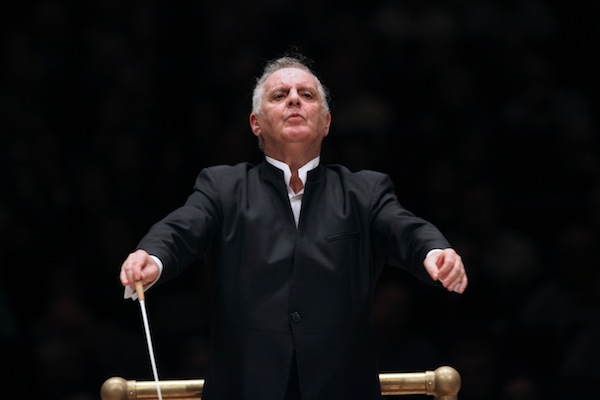Barenboim launches Bruckner cycle with First Symphony, individual Mozart

Daniel Barenboim conducted the Staatskapelle Berlin in Bruckner’s Symphony No. 1 Thursday night at Carnegie Hall. Photo: Steve J. Sherman
One of the most important and widely anticipated events of the classical music season began Thursday night at Carnegie Hall–the first concert of a complete cycle of Anton Bruckner’s numbered symphonies. This appears to be the first sequential Bruckner cycle performed in American history. All of the performances will come courtesy of the Staatskapelle Berlin and its director, Daniel Barenboim, for many the leading Bruckner conductor on the contemporary scene.
Each of the concerts in the cycle—save for the massive Symphony No. 8—will pair a Mozart piano concerto or concertante work with a Bruckner symphony. Thursday night, Barenboim conducted and played Mozart’s final work in the genre, the Piano Concerto No. 27, K. 595, before Bruckner’s Symphony No. 1.
For all his success and renown, Barenboim can be an inconsistent musician, and he is certainly not to everyone’s taste. K.595 balances structural logic against improvisational feel with more internal tension than most other Mozart concertos, and Barenboim’s preference was to press his thumb hard on the improvisational side of the scale.
His playing in the Mozart concerto was a prominent example of why this musician divides opinion; a combination of fine orchestral leadership, fluid technique, and musical choices that were out of the ordinary and thus fulfilling or infuriating, depending on one’s point of view.
The orchestra played with a wonderful, sweet, Central European tone, a refreshing quality in Mozart. Barenboim was more improvisational, even impetuous in his playing.
That impetuosity came through prominently in tempos. Barenboim pushed ahead of the orchestra, even in the Larghetto, and throughout applied rubato within phrases and measures. On top of Mozart’s already decorative solo line, his playing was highly inflected, verging on the type of ornamentation one usually hears in baroque music. With the abundance of notes and flourishes in the music—especially the cadenzas—this often felt like the proverbial taking of coals to Newcastle.
But Barenboim never lost track of the cantabile line in the music. He maintained a warm, legato touch and the feeling of spontaneity, shifting the performance from an objective presentation of notes on the page, to a vivacious and stimulating sense that he and the orchestra were making music together, in the moment.
There were no such issues with the Bruckner’s First Symphony. The only faults in the concert were from the music itself. Symphony No. 1 is not just the composer’s first acceptable to him(there is an extant “Study Symphony” No. 00, and the “Die Nulte” Symphony No. 0) but is still very much an early work. The piece is full of elements and ideas that will come to full fruition in later works—it does have a substantial amount of fine music—and also has passages that suffer from some combination of being derivative, banal, or simply without logic or meaning.
(A note about the edition: due to a combination of Bruckner’s own insecurities and well-meaning editing, and meddling, from others, most Bruckner symphonies exist in multiple editions. The Staatskapelle played what is know as the “Linz” version of Symphony No. 1, the result of two revisions by the composer and the work of two different editors.)
That the orchestra played with such energy and passion, and such a fine sound, bodes well for the rest of the cycle. This is not a big, plush orchestra like the Berlin Philharmonic, but it is agile, colorful, and has an excellent blend and balance between sections.
Bruckner is full of explosive energy, as coiled as anything in Beethoven or Mahler, and Symphony No. 1 burst out of the gate Thursday night.
The music moved back and forth from Bruckner writing his way through the influence of Wagner, and expressing his own voice. Some of the trademarks of that voice are prominent in this symphony, especially the warm, exalted Adagio and the wild physicality of the Scherzo; the orchestra played the former with serene beauty and the latter with just the right seasoning of atavistic savagery.
Their commitment to the music was impressive in the finale, which is structurally scattershot, alternating force and drama with meaningless note-spinning. Passionate, exciting, and powerful, this was the best possible case for the music. Barenboim himself agreed with the sustained audience ovation, returning to the stage to stand in the wings and join in the audience applause for his musicians.
The Bruckner cycle continues through January 29. Daniel Barenboim and the Staatskapelle Berlin perform Mozart’s Piano Concerto No. 20 and Bruckner’s Symphony No. 2, 8 p.m. Friday. carnegiehall.org
Posted Jan 21, 2017 at 5:42 pm by Howard Charles Yourow, S.J.D.
Woulds that I couldst sit in that exalted hall to breathe Meister Anton’s tones!